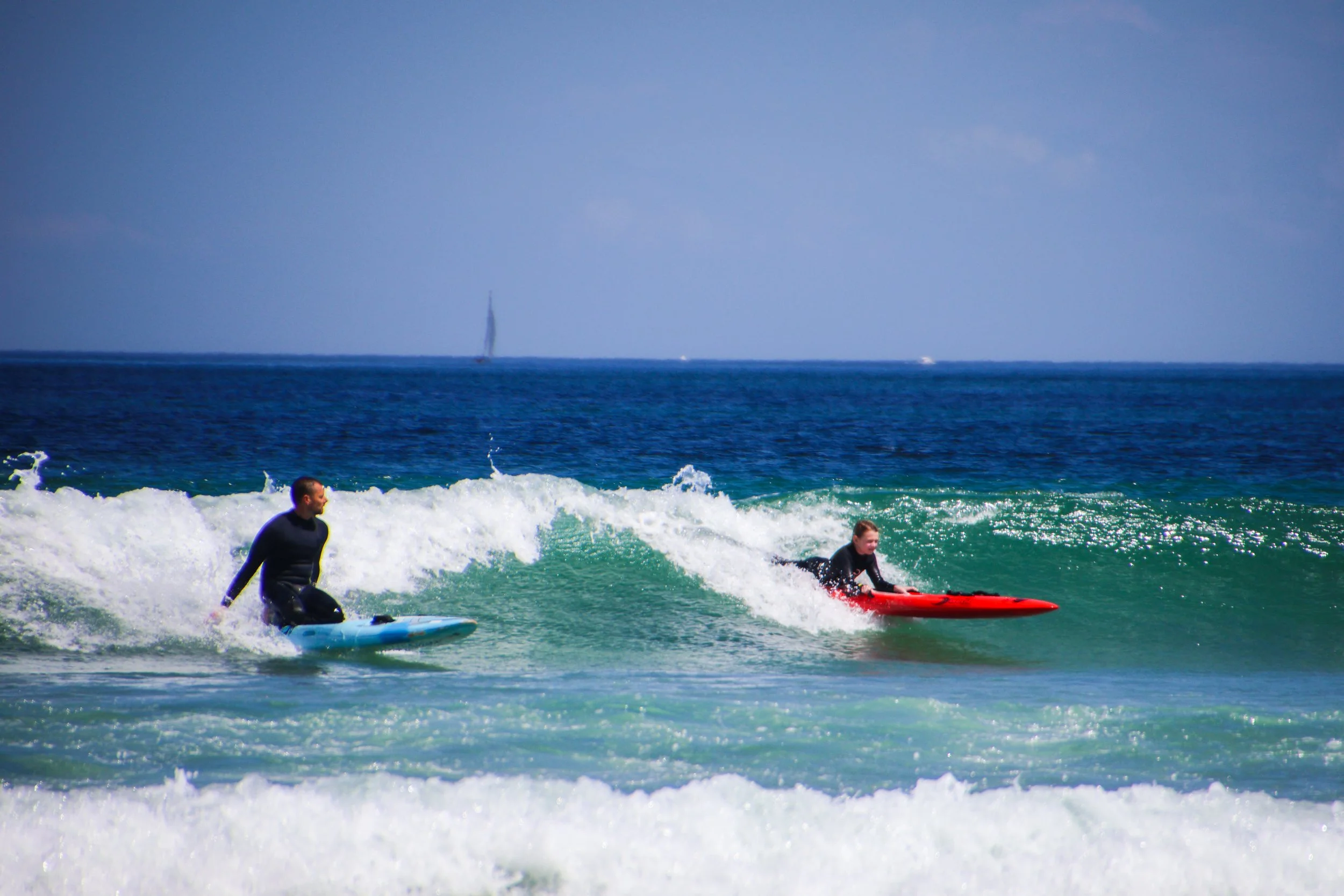We’ll pick up where we left off at the end of the previous article on Hondarribia: on the ferry across the Bay of Txingudi, crossing from the Spanish side of Basque Country, to the French side. Yes, crossing the border between two Schengen Area countries really is this easy. There was no passport check or anything. I threw a guy a couple of Euros to get onto this boat, and 10 minutes later I was in France!
Our destination today is a little town called Hendaye. Pretty much the ONLY thing I knew about Hendaye when I arrived here was that is was Basque. I had long been fascinated with Basque Country, but had only ever thought about it through a Spanish context. This, however, is an incomplete picture of the Basque culture, because it actually straddles this international border in the Bay of Biscay. Both sides deserve thorough exploration… and as far as the French side is concerned… this ain’t it. Admittedly, this article is not the deepest incursion into French Basque Country, but it will hopefully provide a feel for the area. Today, we will wander without agenda or itinerary through the area highlighted on this map below. In looking at this map, you now have as much information about this places as I did when I arrived here. 😂
French Basque Country in 2 Minutes
So, while we’re making this boat crossing, let’s talk about French Basque Country a bit, and how—if at all—it differs from the Spanish side. If you haven’t yet read the first two installments from this series on Spanish Basque Country, they would definitely be helpful context for this article. Here are links to Part 1 (San Sebastian) and Part 2 (Hondarribia) for your reference. French Basque Country—in the Euskara (Basque) language—is called Iparralde, which literally translates to “the northern side.” Iparralde is composed of 3 provinces, all contained within the larger “department” of Pyrénées-Atlantiques: Labourd, Lower Navarre, Soule. And, within the group, Hendaye is located in Labourd.
To provide a point for comparison, Spanish Basque Country is (mostly) contained in an official region of Spain called the Basque Autonomous Community, which is one of the most powerful sub-national entities in Europe. This political autonomy was hard-earned, and the Basque cultural identity retains a strong political arm today, which has enshrined Euskara as a co-official language with Spanish. Euskara is still considered an “endangered” language, but collectively, this has all served as a bulwark against the dilutive forces that threaten to water down the Basque culture in Spain. No such bulwark exists in France.
Oooo pretty pictures! Sorry - give me 1 minute to climb out onto the deck of this boat snap a few pictures of France off in the distance… all these terracotta-tiled roofs with this boat in the foreground are just too good to pass up…
Ok, sorry about that. As I was saying…
Like in Spain, the unifiers of modern-day France had a number of regional cultures and languages that stood in the way of a single, national culture and language. These regional languages included (among others) Corsican, Flemish, Lorraine Franconian, Breton, Occitan, …and Euskara. These languages came under direct threat with the French Revolution in 1790. From that point on, the central powers of France—which would go through a number of bloody iterations before finally finding stability—saw regional languages like Euskara as obstacles to a unified nation. There is no co-official status for the language, nor a political vehicle for French Basques. Unlike in Spain, there was never a serious resistance movement that rose to challenge Paris. As a result, the culture and language today survives more in rural settings than urban areas, and rates of Euskara usage and intergenerational transmission are substantially lower than on the Spanish side. In more recent years, cultural preservation movements have sprung up in Iparralde, but it seems to me that the Spanish side has solidly established itself as “Basque HQ,” with Iparralde being more of a legacy satellite. French Basques: don’t hesitate to contradict me in the comments if I am wrong! I genuinely want to learn!
Please appreciate this map of greater Basque Country that I doctored up to make the delineation between the French and Spanish side more clear. This is the first time I have had to go rogue on the map-making for this blog. 😂
ANYWAY, that’s about as much about French Basque Country as I can give you. Now, it’s time to just wander around and see what this places feels like under my feet.
Plage d'Hendaye
The ferry from Hondarribia ends at a small dock with a ramp that leads to a hot parking lot. When we arrived, the line to cross over from the French side was at least 5x longer than the line to cross to the French side. In fact, there was hardly any line in Hondarribia at all. Our immediate impression was that this was the Jersey side of the Hudson. That’s an NYC joke for ya.
However, after a short walk from that hot parking lot, I found myself looking down an absolutely gorgeous beach: Plage d'Hendaye. The flat, sandy expanse was full of French beach goers, but there was still enough space that I could walk down the beach (in bare feet, of course), without having to invade anybody’s personal space. Just off the coast, under the chilly waters of the Atlantic, the drop-off of the ocean floor was gradual enough that the water turned a tropical shade of teal under the sunny Basque skies. Off in the distance, picturesque rock formations jutted out, bringing this sandy paradise to a scenic end. In the space between, people surfed, sail boats circled offshore, people lay tanning, couples walked in the surf, children built sandcastles… it was all extremely idyllic, like some sort of French Norman Rockwell world.
Back on shore, the beach-front community that spanned the length of the beach was surprisingly scenic! I never expect these sorts of beach-front, commercial areas to be very charming, but France has a way of exceeding my American expectations at every turn. Don’t get me wrong: it’s mostly hotels and restaurants. But it’s a good version of that; and one that feels distinctly French when compared to Hondarribia, which sat just across the river.
It was a beautiful beach, and well worth the trouble of crossing over from Spain… however, I also had academic interests. I wanted to get a flavor for French Basque Country, and this beach was not enough. So, I bid my friends farewell, and began a very long, sweaty, solitary walk toward the center of Hendaye, whose dense cluster of terracotta roofs had been so intriguing from the ferry. The route brought me along the scenic estuary where the Bidasoa River meets the ocean. To my right, I was typically looking at an expansive natural area, intermingling views of beaches and boats, sand and water, grass and rocks… and France and Spain. To my left, suburban streets of vacation homes sat quietly. Or maybe they are people’s year-round homes! But they were giving vacation vibes. In the punishing heat, I wondered if Hendaye was going to be worth the slog… but I was keeping the faith! ✊
It took me quite a while to intuit my way into the central plazas of Hendaye, but when I did, I found them to be unsettlingly empty. Hondarribia had been quite lively, but here on the streets of Hendaye—which were actually quite charming!—there was silence. I am choosing to attribute this to the time of year when I was visiting. The Spanish town of Irun (mentioned in the last 2 articles!) sits just across the river and is well connected by road and rail, which effectively merges its metro area with that of Hendaye. However, whereas Irun’s economy is more industrial, Hendaye’s leans heavily on tourism and leisure. My sources in Paris tell me that it has a reputation for affluence in the world of French vacations. But, the French have seemingly all agreed to only take holidays in the summer and this visit came in the early days of May. So, perhaps this explains the vacant streets? Or maybe they heard I was coming and were all hiding from me. Who knows.
I stopped into a nice little coffee shop for a bit of sugar, caffeine, and water to keep me going. As I sat there sipping my flat white in the quiet of this cafe, it was difficult not to eavesdrop on the conversation next to me. Three women talked amongst themselves, discussing (in English, but with accents) a health issue that one of them was experiencing. Obviously none of my business, but after the loneliness of the streets outside, I was grateful for the the human touch and the reminder that no matter where you go on planet earth, we’re all dealing with basically the same things.
OK, my coffee is gone. Now, while I wander the empty streets with my camera, let me fill you in on one very interesting and consequential piece of history that took place in Hendaye. This was the site of a meeting between Hitler and Franco in October, 1940. The former needs no introduction, but the latter—if you didn’t know—was the dictator of Spain from 1939 to 1975, a time period which most Spaniards remember for repression, censorship, executions, imprisonment, and forced exile.
For context, in 1940 Spain had just emerged from a brutal Civil War, which had all but destroyed the neighboring town of Irun. Meanwhile, France had just fallen that June, and was now under complete Nazi control. Hitler came to Hendaye to try to convince Franco to join the Axis powers in the war. While Franco’s fascist ideology was compatible with that of the Axis powers, Spain was only just beginning to rebuild after its own war. Therefore, Franco demanded massive aid from Germany (grain, fuel, weapons, colonies in Africa) in order to join the war. During this 9 hour meeting, Hitler reportedly grew quite frustrated with Franco’s demands, and later was quoted as saying “I would rather have three or four teeth pulled than go through another meeting with Franco.” So, in a major setback for the Axis, Spain stayed out of the war. History could have turned out very differently had this gone Hitler’s way.
Consquently, until 1944, when the Allies chased German forces out of France, the Bidasoa River was a heavily guarded border, and Hendaye was a major way-point for escape routes and smuggling networks for Jews, downed Allied airmen, and political dissidents. One famous WWII escape network that operated here was the Réseau Comète (Comet Line), which was made up of brave civilian helpers—mostly women—who sheltered these fugitives in safe houses across France and Belgium until they could get to Britain, often via Spain. The risks of being discovered by the Gestapo were severe and, in this region, the Basques were heavily involved in this network! So—for my American readers—this spot on the Bidasoa River is a really interesting parallel to the American Civil War’s Underground Railroad & the Ohio River.
The calm of 2025 is a far cry from dystopia of the 1940s when both Hendaye and Irun were trapped in their own nightmares. Comparatively, I was living the dream. Although society seems to be losing its appreciation for peace as the collective memory of WWII fades, the peaceful aura of Hendaye on this warm May day was not wasted on me. I appreciated it for what it was. Here are some pictures from this charming, albeit quiet little town.
To get back to San Sebastian, I walked to a bus stop in Hendaye, rode the bus back to the water front, walked a bit more to re-locate the ferry terminal, took the ferry across the water, walked to find the right bus stop in Hondarribia, and rode that bus back to San Sebastian, where I began my final walk back to our hotel.
Recall that, by this point, my friends and I had split off for the day, so I was doing this trip solo. Stringing together the various components of this multi-modal journey “home” was a bit empowering! I know this isn’t quite on the level of my solo trekking through Myanmar and India years ago but the sensation was familiar. It was a good reminder of how much I love solo travel. I was sitting alone on the boat crossing from France back to Spain feeling full of life; like, “this is what it’s all about.”
And, if the brave souls who crossed this river in the early 1940s were here today, I’m sure they would agree.




























































































